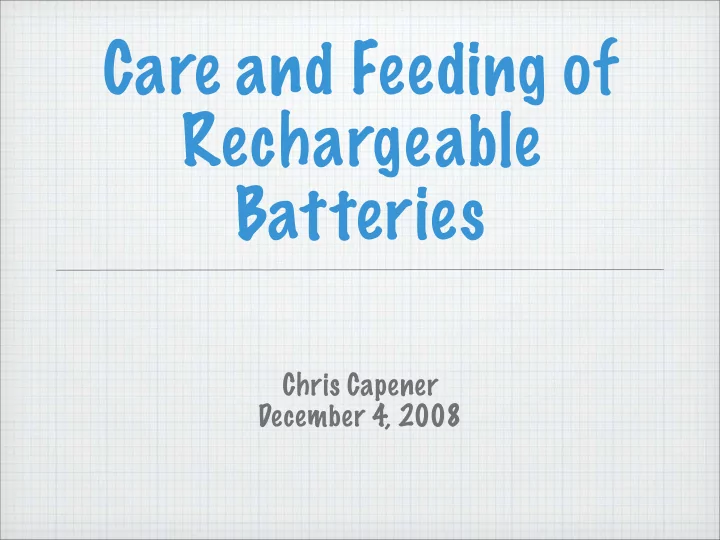

Care and Feeding of Rechargeable Batteries Chris Capener December 4, 2008
Battery Types Lead Acid Nickel-Based NiCd NiMH LSD Li-ion
Battery Charging Lead Acid Nickel-based Battery Packs Analyzers & Chargers
Before We Begin Some Definitions Battery capacity is rated in Amp-hours (Ah) • It is the number of amperes times the number of hours that the battery can supply • A 20 Ah battery can supply 1 A for 20 hours, 4 A for 5 hours, etc. The letter ‘C’ is used to represent the capacity of a battery • Often used in describing charge rates • To charge a 1 Ah battery at a 0.5C rate means to charge with 500 mA
Battery Types Different Chemistries
Sealed Lead Acid (SLA) 7 Ah 26 Ah 40 Ah
Sealed Lead Acid (SLA) Pros Cons Inexpensive and simple to Low energy density - poor weight-to- manufacture energy ratio limits use to stationary and wheeled applications. Mature, reliable and well- understood technology Cannot be stored in a discharged condition - the cell voltage should never drop below 2.10V. Self-discharge is among the lowest of rechargeable batteries Allows only a limited number of full discharge cycles - well suited for Capable of high discharge rates standby applications that require only occasional deep discharges.
NiCd - Nickel Cadmium
NiCd - Nickel Cadmium Pros Cons Fast and simple charge Relatively low energy density High number of charge/discharge Memory effect - nickel-cadmium cycles - over 1000 cycles must periodically be exercised (discharge/ charge) to prevent memory Good load performance Environmentally unfriendly - nickel- Good low temperature performance cadmium contains toxic metals One of the most rugged Relatively high self-discharge - needs rechargeable batteries. recharging after storage Economically priced
NiMH - Nickel Metal Hydride
NiMH - Nickel Metal Hydride Cons Pros Limited discharge current - heavy load 30-40% higher capacity than reduces the battery's cycle life. standard nickel-cadmium More complex charge algorithm Less prone to memory than nickel- needed cadmium Trickle charge settings are critical Environmentally friendly - contains only mild toxins High self-discharge - typically 50% higher than nickel-cadmium High maintenance - nickel-metal hydride requires regular full discharge to prevent crystalline formation
LSD - Low Self Discharge Also known as ‘Hybrid’
LSD - Low Self Discharge Pros (vs. NiMH) Cons (vs. NiMH) Much longer shelf life Lower initial capacity Better cycle life Higher cost Same environmentally friendliness
Shelf Life After only three weeks of storage, the Eneloops have more capacity remaining. After about 3.5 months, the Eneloops will have twice the capacity of the traditional cells.
Cycle Life
Li-ion - Lithium Ion Cons Pros Risk of FIRE if abused Highest energy density available Only available packaged with safety Good cycle life - 500 cycles circuit Complex, tightly controlled charger High cost
Battery Charging Different Procedure for Each Chemistry
Sealed Lead Acid (SLA) Stage 1: Constant Current between 0.1C and 0.3C Stage 2: Constant Voltage at 2.4V/ cell (14.4V for a 12V battery) for 5 hours Stage 3: Float Charge at 2.25V/ cell (13.5V for a 12V battery)
Nickel-Based Avoid high temperature during charging A charger for nickel-metal-hydride can also accommodate nickel cadmium, but not the other way around. A charger designed for nickel-cadmium would overcharge the nickel-metal-hydride battery. Nickel-based batteries prefer fast-charge. Lingering slow charges cause crystalline formation (memory). If not used immediately, remove the battery from the charger and apply a topping-charge before use. Do not leave nickel-based battery in the charger for more than a few days, even if on trickle charge.
Battery Packs And why they often die young
Battery Pack + - Made up of multiple cells in series
Two Cell Example The upper cell has less capacity than the lower one During discharge it will empty first The lower cell still has some capacity left If discharge is continued, the upper cell will be damaged
Two Cell Example A similar problem occurs during charging During charging the upper cell will reach full charge first If charging continues, the upper cell will be damaged Continuing charge/discharge cycles further damage the upper cell and the pack dies
Solution Use a battery pack made from individual rechargeable cells AA battery pack Charge the cells individually outside of the pack Do not run the pack all the way down
Battery Chargers Why to spend a little extra
Considerations Charge cells individually Capable of fast charge Voltage and temperature monitoring Capacity analysis
LaCrosse Alpha BC-900
Battery Analyzers For the truly committed
West Mountain Radio CBA-II
Cadex Battery Analyzer
Acknowledgements & Links Battery University http:/ /www.batteryuniversity.com http:/ /www.stefanv.com/ electronics/sanyo_eneloop.html http:/ /www.eneloop.info http:/ /www.lacrossetechnology.com/900/ http:/ /www.westmountainradio.com/CBA_ham.htm http:/ /www.cadex.com/
Recommend
More recommend